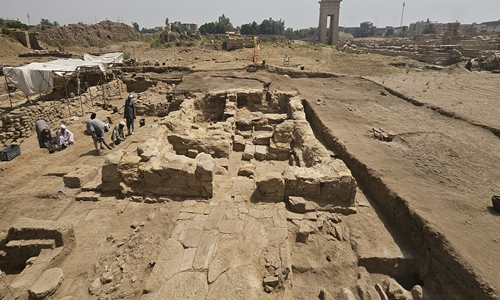
Archaeologists from the China-Egypt archaeological mission at work Photo: Courtesy of Jia Xiaobing
In the prestigious Karnak Temple Complex of Luxor in Egypt, archaeologists from China and Egypt have been working together since 2018 to uncover the 3,000-year-old Montu Temple, gradually unveiling the mysterious story of the ancient site. Both sides expressed that the joint archaeological expedition has helped forge a bond of friendship, making the two civilizations get closer.
In mid-March, the joint archaeological team resumed excavation work at the Montu Temple site after a pandemic-induced hiatus and has since achieved fruitful results.
Jia Xiaobing, the Chinese head of the joint archaeological project and director of the world archaeological research office at the Institute of Archaeology of the Chinese Academy of Social Sciences, told the Global Times that the latest collaboration with the Egyptian team has achieved a deeper understanding compared to his initial experience in 2018.
"Archaeology is the best way to understand the core of the traditional culture of a nation. Although our working season only lasts two to three months, within this period, we deepen our understanding of each other's civilizations," Jia said.
Latest achievements
According to the report released by the China-Egypt joint archaeological team, there are two excavation sites in the current round of work. The first site is in the southwest part of the entire Montu Temple area, where six Osirian Chapels are distributed from west to east. Except for the first and second temples, which have accurate dates and names, more information about the other temples awaits archaeological discovery.
The second site is located at the junction of the Montu Temple and the Maat Temple, focusing on resolving architectural sequence issues.
The Montu Temple was originally constructed around 1391-1355 BC. Jia explained the reason they chose the Montu Temple for the joint archaeological project is that Luxor, known as Thebes in ancient times, was the capital of Upper Egypt during the New Kingdom, amassing many elements of Egyptian civilization's most brilliant period. In addition, the Montu Temple is part of the Karnak Temple Complex, which was a core area of religious belief during the New Kingdom period in Thebes. More importantly, Montu, a falcon god of war in the ancient Egyptian religion, originated from this place.
After two months of excavation, the team has, for the first time, fully revealed the overall outline of the fourth temple on the west side, achieving a breakthrough in archaeological work.
According to Jia, the fourth temple is approximately a 10-meter by 10-meter square sandstone building with a clear structure, and some of the floor stones still have residual inscriptions, which are waiting to be extracted and interpreted. This may help in the dating and naming of the temple.
Although the reliefs and artifacts related to the Osirian belief inside the temple have long been damaged, a stone altar was unearthed in the west room of the fourth temple. Though it is broken, the throne name of Nectanebo I, an ancient Egyptian pharaoh and the founder of the last native dynasty of Egypt, the 30th Dynasty, can be identified on it. This provides a chronological scale for explaining the construction sequence of the building, and the joint archaeological team is one step closer to drawing a complete floor plan of the area.
"Academically, we have gained a complete understanding of the layout and structure of the fourth Osirian Chapels. Although the new special structures have not been accurately understood and interpreted, they also provide basic data for understanding the basic structure of Egyptian Osirian Chapels and the details of the Osirian belief," Jia summarized, adding that some special relic phenomena were found that had not been present in other Osirian Chapels before. As for what it represents, they may need to continue excavation and interpretation next season to gain a clear understanding.
Bolster friendshipAs China-Egypt cultural exchanges have become increasingly close in recent years, the two countries have built close ties in archaeology since both countries boast rich cultural heritages.
In October 2018, the China-Egypt joint archaeological team was officially established according to the agreements signed by both parties.
With previous cooperation experience, Jia said that scholars from both countries have more tacit cooperation in their respective divisions.
Jia introduced that in this joint project, the Chinese archaeological team brought advanced technology and equipment, providing a systematic and scientific top-level design for the excavation of the temple, including how to carry out excavation, recording, display, and research. However, there are differences in archaeological concepts and work models between the two countries.
A member of the Egyptian archaeological team, Ahmed Mahmoud Taher Mohamed, told the Global Times that he was initially skeptical of the Chinese team members, but after continuous communication and collaboration, he found that "they are very good people, and they are very professional in their work."
Now, Mohamed and other Egyptian team members are full of appreciation and trust for their Chinese counterparts. In their spare time, they have also become good friends. "The Chinese food made by the team leader Jia is great," Mohamed said with lingering memories.
Jia told the Global Times that after this cooperation, a closer cooperative relationship has been established between scholars from the two countries, and both sides have a better understanding of each other's cultural traditions, deepening the friendship. "Through cross-cultural comparative studies of material culture history and inner spiritual worlds, we understand the importance of civilization diversity to a colorful real world. It also proves that only through exchanges, mutual learning, understanding, and respect can different civilizations form a community of shared future for all mankind," he said.

Archaeologists from the China-Egypt archaeological mission work at the relic Montu Temple in Luxor, Egypt, in May, 2024.? Photo: Courtesy of Jia Xiaobing





